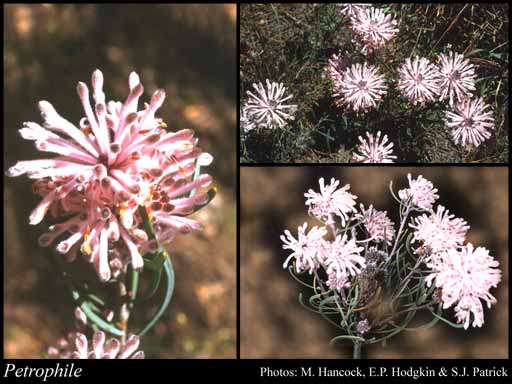- Reference
- Cult.Prot. pxii, 92. (1809)
- Name Status
- Current

Scientific Description
Common name. Conebushes. Family Proteaceae.
Habit and leaf form. Shrubs (or undershrubs); evergreen. To 0.2–3 m high. Mesophytic, or xerophytic. Heterophyllous, or not heterophyllous. Leaves small to large; alternate; usually spiral; leathery; petiolate; non-sheathing; edgewise to the stem, or with ‘normal’ orientation; simple; epulvinate. Leaf blades of P. helicophylla spirally twisted; dissected, or entire; flat, or solid; terete; linear, or obovate; when simple/dissected pinnatifid, or palmately lobed, or dichotomously dissected, or much-divided, or spinose. Leaves without stipules. Leaf blade margins entire, or dentate. Leaves without a persistent basal meristem. Stem anatomy. Secondary thickening developing from a conventional cambial ring.
Reproductive type, pollination. Fertile flowers hermaphrodite. Unisexual flowers absent. Plants hermaphrodite. Entomophilous, or pollinated by unusual means (by small marsupials).
Inflorescence and flower features. Flowers aggregated in ‘inflorescences’; not in pairs subtended by a common bract; in heads. Inflorescences terminal, or axillary; dense, globular, ovoid or cylindrical; axis woody, sessile or pedunculate; usually with involucral bracts, or without involucral bracts; pseudanthial. The fruiting inflorescence conelike. Flowers sessile; bracteate (forming the broad, hardened cone scale), or ebracteate (depending on interpretation); small to medium-sized; regular; 4 merous; cyclic; tetracyclic. Floral receptacle developing a gynophore, or with neither androphore nor gynophore. Free hypanthium absent. Hypogynous disk absent. Perianth of ‘tepals’; 4; 1 -whorled; joined (basally, tepals separating from base, falling united or separated); white, or cream, or yellow, or pink, or purple. Androecial members definite in number. Androecium 4. Androecial members adnate (to tepals); all equal; free of one another; 1 -whorled. Stamens 4; isomerous with the perianth; with sessile anthers (with a short connective). Anthers basifixed; non-versatile; dehiscing via longitudinal slits; introrse; four locular; tetrasporangiate. Gynoecium 1 carpelled. The pistil 1 celled. Gynoecium monomerous; of one carpel; superior. Carpel stylate; apically stigmatic. Style straight (the pollen presenter fusiform or distinctly enlarged, basally truncated, terminally brush-like, glabrous or hairy; stigmatic surface glabrous, minute). Carpel 1(–2) ovuled. Placentation marginal, or apical. Ovary sessile. Ovules funicled, or sessile; pendulous; non-arillate; orthotropous, or anatropous, or amphitropous, or hemianatropous.
Fruit and seed features. Fruit persistent; non-fleshy; usually hairy (either marginally or basally), or not hairy. The fruiting carpel indehiscent; nucular (nut often compressed, more or less ovoid to obovoid, sometimes winged; style base more or less persistent). Endocarp frequently crystalliferous. Seeds non-endospermic. Embryo well differentiated. Cotyledons 2(–8). Embryo straight.
Special features. Cone scales persistent, opening to release the nuts. Stamens inserted within a concavity near the end of a perianth segment.
Geography, cytology, number of species. Native of Australia. Endemic to Australia. Australian states and territories: Western Australia, Queensland, and New South Wales. Eremaean Botanical Province and South-West Botanical Province. N=13.
Etymology. From the Greek for "rock" and "to love"; often spelt Petrophila.